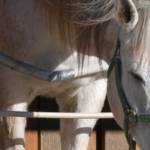Prevalence of Cecal Intussusceptions in New Zealand

California researchers performed a retrospective study on the prevalence of cecal intussusceptions. An intussusception occurs when a segment of intestine pushes into another section of the organ, similar to the way in which a camera lens slides in and out of its casing, and remains fixed. Intussusceptions often result in obstructions and colic symptoms.
Using data from the Massey University Veterinary Teaching Hospital, Palmerston North, New Zealand, in which 135 horses were admitted for colic surgery between 1991 and 2004, University of California-Davis researchers found that 61 horses were diagnosed with ileocecal (37), cecocecal (5), or cecocolic (19) intussusception.
According to the investigators, intussusceptions involving the cecum should be considered as a differential diagnosis in horses presenting with chronic low-grade colic. Transabdominal ultrasound is useful for identifying cecocecal and cecocolic intussusceptions.
The high prevalence of intussusceptions involving the cecum seen at this referral hospital may indicate a higher prevalence in New Zealand than is reported elsewhere in the world.
The full-length article, “Caecal intussusceptions in horses: A New Zealand perspective,” was published in the July 2010 issue of the Australian Veterinary Journal.








